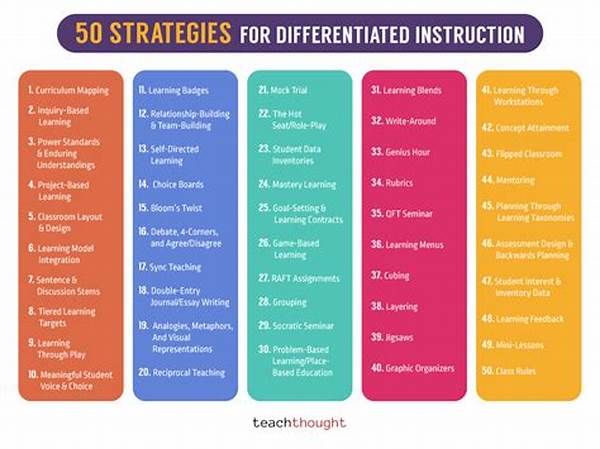In the contemporary educational landscape, educators are consistently challenged to meet the diverse needs of their students. Differentiated instruction, a pedagogical approach that acknowledges and addresses student differences, has become a crucial strategy to enhance learning outcomes. Educators are tasked with the significant responsibility of crafting lessons that cater to a variety of learning styles, abilities, and interests. This article aims to shed light on differentiated instruction strategies for educators, providing insights into methods that facilitate effective teaching across diverse classroom settings.
Read Now : Fashion Innovation Summer Program
Understanding Differentiated Instruction
Differentiated instruction strategies for educators encompass a broad spectrum of techniques aimed at enhancing students’ educational experiences by accommodating individual learning needs. At its core, differentiation involves modifying the curriculum and teaching methodologies to better suit learner variances. Educators who employ differentiated instruction often adapt content, processes, and products based on student readiness, interest, and learning profiles. Through flexible grouping, educators can address specific learner needs while fostering an inclusive classroom environment. The goal is to ensure that all students have equitable access to learning, leading to improved academic performance and personal growth. Differentiated instruction strategies for educators not only promote academic success but also encourage a culture of respect and acceptance among students.
Implementing Differentiated Instruction Techniques
Implementing differentiated instruction strategies for educators requires a thorough understanding of students’ individual needs. By using pre-assessment tools, educators can identify students’ strengths and areas for growth.
1. Flexibility in group work allows educators to tailor activities based on varying skill levels.
2. Continuous assessment and feedback further allow for adjustments in instruction.
3. Incorporating a variety of learning materials caters to different learning preferences, such as visual, auditory, and kinesthetic.
4. Educators are encouraged to cultivate a growth mindset, emphasizing effort and persistence over innate ability.
5. Technology can also be leveraged to provide personalized learning experiences, aligning educational content with each student’s pace and level of understanding.
Read Now : Contemporary Art Market Analysis
Benefits of Differentiated Instruction
The application of differentiated instruction strategies for educators leads to numerous benefits in the educational setting. Firstly, it encourages student engagement by offering tailored learning opportunities that align with their interests and abilities. By emphasizing individual strengths, educators can foster a positive learning environment where every student feels valued and understood. Secondly, differentiated instruction supports the development of critical thinking and problem-solving skills. As students are challenged at their own level, they are more likely to experience intellectual growth and enhanced self-efficacy. Lastly, this approach nurtures a diverse and accepting classroom culture, preparing students to navigate and thrive in a multicultural society.
Challenges in Implementing Differentiated Instruction
While differentiated instruction strategies for educators present numerous advantages, implementing them can be challenging. Resource limitations, such as lack of time and materials, can hinder effective differentiation. Additionally, educators may face difficulty in balancing individualization with curriculum standards. Professional development and collaborative planning are essential in overcoming such obstacles. Schools must support educators by providing access to resources and ongoing training to equip them with the necessary skills and knowledge. Despite these challenges, the effort to implement differentiated instruction is a worthy investment, as it ultimately contributes to a more equitable educational landscape.
Practical Examples of Differentiated Instruction
Practical application of differentiated instruction strategies for educators involves creative approaches to lesson planning. For instance, in a mathematics class, educators might use tiered assignments to address varying levels of mathematical understanding. Advanced students could engage in complex problem-solving tasks, while others work on foundational skills with guided support. Similarly, in language arts, a literature circle allows students to select books aligned with their reading level and interest. As students discuss their chosen books, they develop reading comprehension skills in a collaborative setting. Such strategies exemplify the versatility and effectiveness of differentiated instruction in promoting student achievement.
Conclusion
In conclusion, differentiated instruction strategies for educators play a pivotal role in crafting a responsive and inclusive learning environment. Despite various challenges, the adaptation of teaching methods to accommodate individual differences is essential for unlocking every student’s potential. By employing differentiated instruction strategies, educators create pathways for students to engage, succeed, and flourish. This individualized approach not only enhances academic performance but also fosters a sense of belonging and appreciation for diversity in the classroom, laying the foundation for lifelong learning and success.
